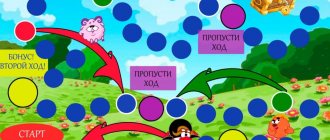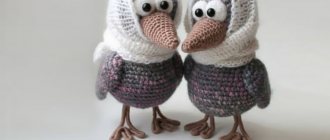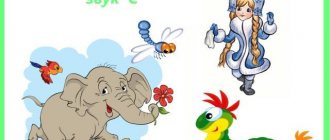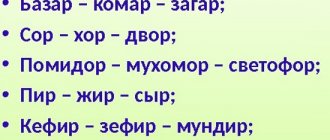By the time they reach 4 years of age, most children can pronounce whistling sounds such as “Ts.” Some require the help of a speech therapist. Automation of the sound “C” occurs through classes, the main elements of which are exercises for repeating syllables and words with the sound being studied.
The child can find objects whose names contain the letter C and pronounce them.
Ways to make the sound “Ts”
There are several ways to set “C”. During the study process, the specialist selects speech therapy classes individually for each child.
- Production of “C” by imitation using game situations. Game “Don’t wake the baby”: put your finger to your mouth and say “Hush, hush, the baby is sleeping in her crib. Don’t wake him up, t-t-t-t-t!” Game “Feed the chicken!”: invite the child to repeat “Chicken, chicken, chicken, chicken!”
- The mechanical method is to use an auxiliary object. Often a teaspoon is used for these purposes. With its help, it is necessary to hold the tip of the tongue behind the teeth at the moment when the child tries to pronounce the sound “Ts”. In this case, the tongue should take the shape of a slide, its tip rests on the lower incisors, and the back touches the upper teeth and upper palate.
- Setting “C” from reference sounds. This method is used when a preschooler can pronounce the sounds “T” and “S”. The adult asks the child to use them quickly. Repeat this pronunciation several times.
Examples of words starting with the letter C
There is a good story about our favorite letter that lists words starting with the letter c for children. One day the children noticed the letter C was missing. It was there, and then it disappeared suddenly. Then the children thought: where to look for her?
The answer was found quickly - in the circus! We got there, but there were no letters. Then, at the very end of the performance, the circus performer took out a cylinder and began to take out various objects from it. First I took out the flowers. But the circus performer didn’t think it was enough and chickens crawled out of the cylinder. After another swing, a huge heron came out, followed by a runaway letter “C”.
...first he took flowers out of his hat...
Correct articulation
Scheme of articulation of the sound C and S.
When pronouncing “C” correctly, the tip of the tongue rests on the lower incisors. Its body is arched, its back closes to the sky, and its edges are in tension. When the air flow leaves the mouth, there is an instantaneous opening of the tongue and palate. At this moment, the tip of the tongue moves slightly away from the lower teeth, thereby increasing the flow of escaping air.
The lips assume the position of a stretched smile. When pronouncing words containing straight syllables with the sound “C”, for example “sheep tso tso tso”, the teeth open.
Exercises
Before learning how to correctly pronounce the sound “C,” breathing is taught in speech therapy classes. Gymnastics is especially necessary for nasal defects.
Breathing warm-up – game activity “Butterfly”.
Items: paper butterflies 2-3 pcs. They can be cut out of paper or bought ready-made. We attach a string to each and hang it in front of the baby’s face.
Actions: invite your child to blow on the butterflies as hard as possible. They should fly apart in different directions. Make sure your inhalations are slow and your exhalations explosive and intermittent. Before classes, you can recite poems, sayings, and sing songs:
Fly, fly butterfly
High to the sky
There are your children -
On an aspen branch.
Repeat the game 2-5 times. Make sure your child doesn't get bored. For the older group of kids, classes are chosen that are more difficult. For example, blow a piece of cotton wool or a piece of napkin from the tip of your nose. Using your breath, try to keep the object from touching the ground for as long as possible.
Articulation exercises
Experts use such classes in preparatory groups. Initially, children need to train their speech apparatus.
Don't miss: What exercises to make the sound D and D
Gymnastics for lips:
- We stretch our lips into a smile. They are in tension.
- We close our teeth.
- The bite is natural.
- We do not push the front and upper incisors forward.
- Hold the position for 10-15 seconds. Repeat the warm-up up to 5 times in front of the mirror.
Gymnastics for the tongue:
- Knead the dough (develops the ability to hold your tongue correctly). We smile and open our mouth as wide as possible. We place the speech organ on the lower lip. We start saying la-la-la-la while we slap our lips on the calm tongue. The air stream should come out gradually. To control the breathing process, use a piece of cotton wool. Bring it to your baby's mouth. The task is completed correctly if the cotton wool deviates slightly. The duration of the lesson is 15-20 seconds, 2-3 approaches.
(muscle strengthening). We open our mouth. The lips are smiling. The wide tongue stretches upward. We try to reach the tip of the nose. Then we lower the speech organ down. We reach to the chin. Then we reach for the upper lip with our tongue. Then we reach the bottom. We also do it in turns with the teeth. Then we hide our tongue inside and touch the alveoli at the top and bottom. We rest for 15 seconds. It is important to ensure that the speech organ remains wide during gymnastics.
Swing- Coil (practicing the skill of raising the sides of the tongue). Open the oral cavity. Keep your lips smiling. We place the tip of the organ on the front central incisors. The sides touch the upper molars. We roll the body of the tongue forward and then back into the oral cavity. It is important that the tip of the organ is wide and does not protrude beyond the teeth. The articulatory apparatus is motionless. We perform 2-3 times with a break of 20 seconds.
It is important to move on to a new
level of training after mastering the previous one. The child must complete tasks clearly and quickly.
Articulation gymnastics
To make the sound “C”, it is necessary to pay special attention to special articulatory gymnastics. Exercises will be more effective if performed in front of a mirror. You need to start classes by warming up your tongue and lips.
You can invite your child to stretch his lips into a smile several times in a row and slap his lips with his tongue. It is better to start with easy exercises and gradually move on to more difficult ones.
Tongue exercises
- “Hamster”: rest your tongue on each cheek in turn and stay in this position for a while.
- “Pancakes”: stick out your tongue and place it on your upper lip in a relaxed state. Hold your tongue in this position for several seconds.
- “Painting the fence”: open your mouth, stretch your lips slightly. Use the tip of your tongue to move along the inside of the lower incisors up, down, and in different directions.
- “Slide”: arch your tongue upward. The tip of the tongue should rest against the lower teeth.
- “Eating jam”: with your mouth open, take out your tongue and lick your lower and upper lips in turn. The exercise should be performed by tensing the muscles of the tongue.
An exercise in which a child repeats words with the letter C after an adult.
For lips
- “Tube”: form your lips into a tube and hold them in a state of tension for a few seconds. Repeat the exercise 5-10 times.
- “Fence”: move your lips apart, exposing your teeth. The jaws are clenched. Stay in this position for 5 to 10 seconds.
To develop exhalation
- “Breeze”: place the tongue in a slide so that its tip rests against the lower teeth. Pass a stream of air along the tongue.
- “Pump”: insert the tip of the tongue between the teeth, while sharply opening them. The tongue must be forcefully returned to the teeth and at the same time a stream of air must be applied. When the exercise is performed correctly, a hard “T” sound is heard.
Origin of the letter
Finding out whether a sound is soft or hard is not difficult. It is much more difficult to establish the origin of the mysterious letter. Unfortunately, it is almost impossible to find the homeland of the letter. Letters that were written in an almost identical manner are included in many ancient alphabets. Among them are the Ethiopian or Aramaic language, the Coptic script.
Information about whether the letter c is hard or soft in all these languages could indirectly suggest the answer. If there is a moment of separation into hard and soft letters, the discovery would bring researchers closer to answering the question.
Another way to find out is to determine whether the sound t is soft or hard and whether it exists at all. If you can find the moment of separation of one sound into components, or, on the contrary, the moment of unification, the discovery will help you get closer to the answer to the riddle.
But many scientists are studying all these questions, but no answers have been found. Perhaps the situation will change soon.
Types of incorrect sound pronunciation
Children often try to replace the sound “C” with other consonants, the pronunciation of which is easier and does not require additional work of the tongue muscles. For example, replacing “C” with “S” (syplenok, rash, rash, rash), with “T” (chicken, typ, typ, typ), sometimes with “F” and “Ch” (fyplenok, phyp, phyp, fip, chiplenok, chip, chip, chip).
First, the adult asks the child to pronounce a control phrase (Chicken Little has a chain) to determine the correct pronunciation of the morpheme. Based on this, the speech therapist determines the method of sound production. If the child’s tongue tries to jump out of the mouth when pronouncing “C,” then we are talking about interdental sigmatism.
A teaspoon, with which you need to hold the tongue behind the lower teeth, will help correct this speech impediment.
When “C” in speech is replaced by sibilants, this is called sibilant sigmatism. In this case, we make the sound “C” by imitation using a mirror.
If “C” is replaced by the letter “F” during pronunciation, then the child has labiodental sigmatism. The index finger will help to cope with this problem, with the help of which you need to hold the lower lip while pronouncing the morpheme. As soon as the labial articulation returns to normal, the supports can be removed.
How to write the letter C
We start writing the letter c from the top, first draw a vertical stick from top to bottom, then draw a small line to the left and then a vertical line up. Then we put a stroke at the bottom - this is the final line of our letter. We write a small printed letter c in the same way as a large letter, only in a smaller size.
The capital letter c is written like a capital letter and only at the bottom of this letter we write a loop. Look at the picture and try to write the letter C correctly.
Printed and capital letter c
General recommendations
As a rule, by the age of 3-4 years, children begin to use whistling sounds in their speech. If this does not happen, you need to seek the help of a specialist or try to correct this problem yourself through articulatory gymnastics and speech therapy exercises.
The problem of a child’s speech defect should not be left to chance, since incorrect pronunciation of sounds will also be reflected in the spelling (dysgraphia).
Classes should be selected taking into account the age and individual characteristics of the child. Experts recommend practicing every day for 5-10 minutes, then the result will not be long in coming, and the child will not be overtired.
Types and mechanisms of violations
Incorrect pronunciation of a whistling group is called sigmatism, and replacement in speech with other sounds is called parasigmatism. Sigmatisms differ in the mechanisms of the disorder. The reasons are the structural features of the organs of the articulatory apparatus.
These include:
- malocclusion;
- weak or increased muscle tone of the tongue;
- cleft lip, palate.
The listed anatomical features lead to disruption of articulatory motor skills, which is one of the reasons for incorrect pronunciation. The most common reason is incorrect tongue position. If it is located between the teeth, then speech will be lisping. He may take a position to pronounce T or S, then the phoneme will sound unclear.
The tongue may move to the side and the air stream will not pass through the center, but through its side edge, resulting in a “squelching” effect. Or it may rise strongly towards the sky, causing the air stream to escape through the nose and speech to sound nasal. The articulation may be similar to the articulation of sibilants, and C will sound like F.
Sigmatisms are also signs of the following speech disorders:
- dyslalia;
- dysarthria;
- rhinolalia;
- alalia.
In addition, the reasons for sound distortion can be social:
- When communicating with a child, adults distort speech, resulting in the so-called lisp. Such communication can be maintained until the child begins to speak. He must hear the correct pronunciation of sounds so that later his speech will be literate.
- The child communicates with adults or children who have difficulties with sound pronunciation and imitates their speech. It is necessary that these people begin to correct their speech, or try not to use words that have a “difficult” sound. Especially if you are already going through the automation stage.
Most often, C is replaced with other sibilants or with T. This is due to the fact that it combines two sounds, so if a child’s phonemic processes are not sufficiently developed, then he may not be able to distinguish the desired phoneme from others due to similar acoustic and articulatory features. And this is also due to incorrect pronunciation. Corrective work depends on the cause of the appearance of sigmatisms and parasigmatisms.
Speech diagnostics
To determine the cause of the violation of sound pronunciation, it is necessary to make a diagnosis of speech development. The speech therapist begins his work by examining the articulatory apparatus: appearance, motor skills. To do this, he asks the child to perform exercises to maintain the desired posture - in the case of a whistling group of sounds, they practice the lower position of the tongue, holding it behind the teeth, and dynamic tasks that help assess the mobility of the lips and tongue. First, the speech therapist shows the exercise, then asks the child to repeat it.
Speech therapy diagnostics includes tasks to assess speech breathing. The specialist pays attention to how the child inhales and exhales, and whether his diaphragm is working. To assess the force of exhalation, you can offer to blow away a light object or play the pipe.
Speech material must be selected not only from C, but also from C and T, because production of a given sound can only begin if the child pronounces the reference phonemes correctly.
The child repeats all tasks for naming syllables and words after the adult. It's the same with phrases and sentences. All instructions must be clear and the adult's pronunciation must be clear.
And in tasks for coherent speech, the speech therapist asks the child to compose a short story based on the picture or tell something about a subject that is close to him. You need to select the material so that one word and sentence does not contain C, S and T at once.
Then the child is offered tasks to identify the desired sound among others. Then the speech therapist shows him pictures and asks him to name words that contain C. Before completing the sound analysis task, the adult explains to the child what the beginning of a word, the middle and the end are. Then he says a word and asks to determine where the sound is.
In addition to speech diagnostics, the speech therapist must communicate with parents. This is necessary not only to advise them on all important issues and explain the corrective work plan. So the specialist will also determine in what speech environment the child is being brought up and whether it is necessary to carry out work in this direction.
In Slavic languages
Unlike the Russian language, where the letter “ts” is always hard, the issue of the pairing of the letter “ts” in other Slavic languages, including Bulgarian, Belarusian or Ukrainian, is resolved differently. Here the letter “c” can be in both the “soft” and “hard” versions. The soft pronunciation of the "ts" in the words "pepper" or "bird" sounds like "pepper" and "bird". Surnames of Ukrainian origin can be easily identified by the same feature: they contain a soft letter “ts”, consisting of the sounds [ts,] (Katsyuba).
The combination of two soft sounds [t,s,] is increasingly transformed into one sound [t,]. This was especially evident in the Belarusian and Polish languages, where the letter “c” is pronounced as [t,].
Let's start with an articulatory warm-up!
A child who mispronounces one of the whistles will probably mispronounce the rest of them, by analogy with the first one. The most common reason for the incorrect pronunciation of these sounds is the inflexibility of the organs that are involved in its reproduction. This is why regular exercise is so important. Mobility is not achieved with one lesson, but is developed with each new lesson. There should be no breaks in daily exercise.
The best time is morning. To conduct the lesson you only need three minutes of time before breakfast. Always teach your children in the form of games. To conduct articulation warm-ups you need to know several rules:
- Perform no more than 2-3 exercises at a time, but each exercise is repeated many times.
- Do not introduce more than one new exercise at a time; if there are difficulties with the old exercises, it is forbidden to include a new one in the process until the old one has been worked out.
- A mirror is the best assistant when working on correct articulation. All your movements and the work of the baby’s speech apparatus should be visible to the child, so that he has the opportunity to compare what he sees in you and in himself.
- Not just any exercise – there is gymnastics! If you came to training and lazily waved your arms, you will never be successful. It’s the same when working with pronunciation: all exercises must be done well.
- Do not scold your child for those moments when he does not succeed, especially do not be upset yourself. Everything requires skill. Praise your child for any correctly performed movement.
Sound and noise
The number of consonant letters in the Russian language is 21. One part of them is pronounced with the participation of voice and noise, and the other - only with the participation of noise. Accordingly, the first part refers to voiced consonants, and the second, accordingly, to voiceless consonants.
The next characteristic by which consonant letters are divided is hardness and softness, which depend on the vowel letter following the consonant in the syllable.
- If you try to shout out the letters: k, p, s, t, f, x, c, w, then you will have difficulties, since their articulation does not involve the participation of the voice: all these letters are voiceless. Elementary school teachers suggest memorizing the sentence: “Styopka, do you want some bacon? Fi!”, which contains the entire set of voiceless consonants. But they are wonderfully pronounced in a whisper.
- But you can easily shout out the letters: b, c, d, d, g, z, j, l, m, n, r, since their pronunciation involves sound vibrations formed by ligaments and changed through articulation. These are voiced consonants. But if you try to whisper them, you won’t succeed.
In colloquial speech, voiced and voiceless consonants can be pronounced almost identically: live - sew; goal - count; day is a shadow, but their meanings do not coincide.
Let's make friends with the sound C!
If you correctly organize the work of the articulatory apparatus, then when pronouncing C, the lips should stretch into a smile, and the teeth should form a thin gap. In this case, the tip of the tongue is tightly pressed against the base of the lower teeth, and the tongue itself is curved, like the back of a cat. For the sound to “work”, the air stream must be strong and narrowly directed.
A child sometimes makes mistakes. What are the most common mistakes you see?
- Instead of C we hear other sounds.
- The sound C completely disappears from words.
- It is pronounced S, but sounds distorted, such as soft.
When you are sure that the child's mouth has taken the exact position for reproducing C, then start by imitating in front of the mirror, as mentioned above. Play with the C sound - for example, blow away specks of dust or fluff. A great method that can be used in this exercise is reference sounds. For S, there are two reference sounds that you need to learn to speak in order to pronounce S: these are I and F.
As soon as the child can master C separately, he needs to move on to words and sentences, and in the final final stage, use tongue twisters.
What to do at the differentiation stage
At the differentiation stage, correction of parasigmatisms is carried out. The speech therapist or parents offer tasks for phonemic processes. An adult must pronounce sounds clearly and emphasize them strongly with his voice. This is due to the fact that if the child pronounced the mixed sound incorrectly, then he heard the phoneme distorted.
If it is difficult for him to identify the desired phoneme by ear, offer to repeat it after an adult. Gradually, the baby will learn to complete the task by ear. Offer to find a phoneme in syllables and words. Pay attention to articulation, especially if you rely on pronunciation when performing exercises.
Work on the sound analysis of the word. Explain to your child where the beginning, middle and end of the word are, what sounds are called consonants and vowels. Be sure to characterize C, practice identifying the place of the phoneme in syllables. Then start working with words.
Invite your child to divide the pictures into groups with certain phonemes. First choose phonemes that are completely different in acoustic and articulatory characteristics. Then, when you reinforce the correct pronunciation of words, include phonemes from the same group (C and C) in your lessons.
Carry out correction work gradually; there is no need to burden the baby with a lot of information. It is step-by-step that is an important component of successful training.
Every letter has a riddle
So, as it turns out, the letter “c” is not so simple.
By the way, it is present in all canonical alphabets of the Slavs, listed as “tse”. In church literature and in the Old Church Slavonic language it was called “tsi”, and sometimes “tsi”.
The modern version of the spelling of this letter goes back to the Cyrillic alphabet. But where and how it appeared there is no longer possible to find out. One thing is clear: similar outlines of the letter “c” can be seen among the ancient Arameans, Jews and Ethiopians.
Calling Z is on our shoulder!
Z is very similar to the previous C in terms of the arrangement of parts of the articulatory apparatus. The only difference is that when pronouncing a voiced Z, you need to add a voice. Don't start practicing Z until you have made the S sound. Place your child's hand on the vocal cord area of the neck and say S and Z in turn. When pronouncing Z, the baby will feel vibration, but when saying C it is absent. This vibration is produced by the sound stream, that is, the voice.
As the baby develops the sound Z more and more clearly, ask him to say it louder. And then move on to integrating Z into words and sentences.
Duration and tips for organizing correctional work
The duration of therapy depends on the speech disorder and how parents responsibly approach speech therapy sessions. Their number should be at least 3-4 times a week. Their duration depends on the age of the child. Be sure to use visual material.
It's okay if automation takes longer in syllables and words. Often, consolidation in coherent speech occurs faster because the child has mastered correct articulation. But you only need to automate clear sound without distortion.
For correctional work to be effective, you may need the help of other specialists, especially if the child has a complex speech disorder. This is a defectologist, a neurologist, because in this case it is necessary to provide a complex impact.








